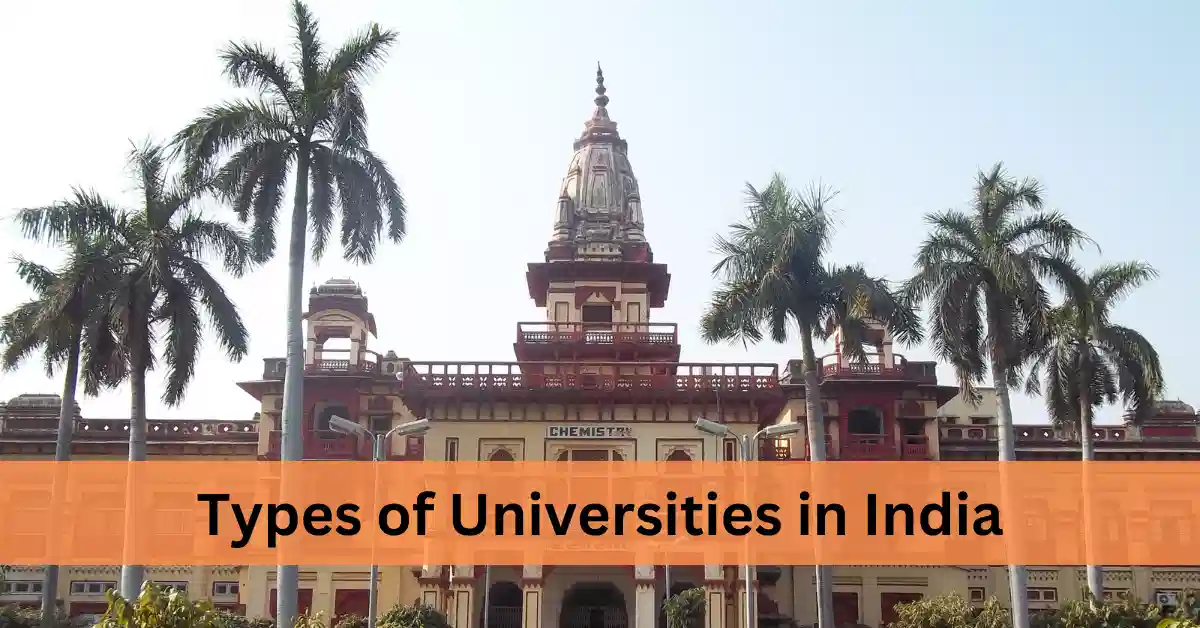India’s higher education system is vast and diverse, comprising various types of universities in India, each serving a unique purpose. Understanding these classifications is essential for students, educators, and policymakers. Here’s an overview of the primary university categories in India:
Table of Contents
1. Central Universities
Definition: Established by an Act of Parliament, central universities are under the purview of the Department of Higher Education in the Ministry of Education. They are funded and regulated by the central government.
Examples:
- University of Delhi (DU): Established in 1922, DU is one of India’s premier institutions offering undergraduate and postgraduate programs in various disciplines.
- Jawaharlal Nehru University (JNU): Known for its emphasis on research and social sciences, JNU has garnered a reputation for academic excellence.
- Banaras Hindu University (BHU): Founded in 1916, BHU is a renowned institution offering courses in arts, science, engineering, and more.
Significance:
- Uniform Academic Standards: Central universities ensure consistent educational quality across the country.
- Funding and Support: They receive direct financial assistance from the central government, ensuring robust infrastructure and resources.
- National Integration: These institutions attract students from all over India, promoting cultural diversity and unity.
2. State Universities
Definition: Established by state legislatures, state universities are primarily funded and managed by state governments. They cater to the educational needs of their respective regions.
Examples:
- University of Mumbai: Established in 1857, it is one of the oldest universities in India, offering courses in humanities, sciences, and commerce.
- University of Madras: Founded in 1857, this university has a rich legacy and offers various undergraduate and postgraduate programs.
- Jadavpur University: Located in Kolkata, it is renowned for its engineering, arts, and science faculties.
Significance:
- Regional Development: State universities play a pivotal role in addressing the educational and developmental needs of their regions.
- Accessibility: They provide affordable education to a broader segment of the population.
- Cultural Preservation: These institutions often focus on regional languages, arts, and traditions, preserving local heritage.
3. Deemed-to-be Universities
Definition: Deemed-to-be universities are institutions recognized for their high academic standards and granted autonomy by the University Grants Commission (UGC) under Section 3 of the UGC Act, 1956.
Examples:
- Indian Institute of Science (IISc), Bangalore: Established in 1909, IISc is a premier institution for advanced scientific and technological research and education.
- Tata Institute of Social Sciences (TISS), Mumbai: Founded in 1936, TISS is renowned for its programs in social work and social sciences.
- Symbiosis International University, Pune: Established in 2002, it offers a range of programs in law, management, and humanities.
Significance:
- Academic Autonomy: These institutions have the freedom to design their curricula, fostering innovation.
- Specialized Programs: They often offer niche courses tailored to specific fields, enhancing expertise.
- Research Opportunities: With autonomy, there’s a greater emphasis on research and development.
4. Private Universities
Definition: Established through state or central acts by private entities, private universities are self-financed and aim to provide quality education with modern infrastructure.
Examples:
- Amity University: Established in 2005, it offers a plethora of programs across various disciplines.
- Ashoka University: Founded in 2014, it is known for its liberal arts education and interdisciplinary approach.
- Shiv Nadar University: Established in 2011, it emphasizes research and a multidisciplinary curriculum.
Significance:
- Innovation: Private universities often introduce contemporary courses and teaching methodologies.
- Infrastructure: They tend to have state-of-the-art facilities, providing a conducive learning environment.
- Global Collaborations: Many have tie-ups with international institutions, offering global exposure to students.
5. Open Universities
Definition: Open universities specialize in distance learning, offering flexible education opportunities to those who cannot pursue regular courses.
Example:
- Indira Gandhi National Open University (IGNOU): Established in 1985, IGNOU is the largest open university in India, offering a wide range of programs through distance education.
Significance:
- Accessibility: They provide education to those in remote areas or with time constraints.
- Flexibility: Students can learn at their own pace, balancing education with other commitments.
- Cost-Effective: Open universities often have lower fees, making education affordable.
6. Autonomous Institutions
Definition: Autonomous institutions are colleges or institutes granted autonomy by the UGC. While affiliated with a university, they have the freedom to design curricula, conduct examinations, and manage administrative affairs.
Examples:
- St. Xavier’s College, Mumbai: Established in 1869, it offers undergraduate and postgraduate programs in arts, science, and commerce.
- Loyola College, Chennai: Founded in 1925, it is renowned for its programs in commerce, arts, and sciences.
- Mount Carmel College, Bangalore: Established in 1948, it is known for its courses in humanities, science, and commerce.
Significance:
- Curriculum Design: Autonomous institutions can tailor their courses to meet industry standards and emerging academic trends.
- Examination Authority: They have the autonomy to conduct their own examinations, ensuring timely assessments and results.
- Administrative Flexibility: These institutions can implement innovative teaching methodologies and administrative reforms without external constraints.
7. Institutes of National Importance (INIs)
Definition: Institutes of National Importance are premier public higher education institutions recognized by an act of the Parliament of India. These institutions are pivotal in developing highly skilled personnel within specific regions or fields. They enjoy special recognition, greater autonomy, and direct funding from the Government of India.
Examples:
- Indian Institutes of Technology (IITs): There are 23 IITs across India, renowned for their engineering and technological education.
- All India Institutes of Medical Sciences (AIIMS): With multiple branches, AIIMS institutions are leaders in medical education and research.
- National Institutes of Technology (NITs): A group of 31 institutions offering quality engineering education.
Significance:
- High Academic Standards: INIs set benchmarks for excellence in their respective fields.
- Research and Innovation: They are at the forefront of research, contributing significantly to technological and scientific advancements.
- Global Recognition: Degrees from these institutions are recognized and respected worldwide, enhancing graduates’ employability.
Conclusion
India’s higher education system is diverse, with each university type playing a unique role in shaping the nation’s academic landscape. Understanding these Types of Universities in India helps students make informed choices for quality education and career success.
As of November 14, 2023, the UGC lists 1,114 universities, including 56 central, 479 state, 124 deemed, and 455 private universities (Wikipedia).
What matters most to you when choosing a university—accreditation, faculty, placements, or something else? Share your thoughts!

